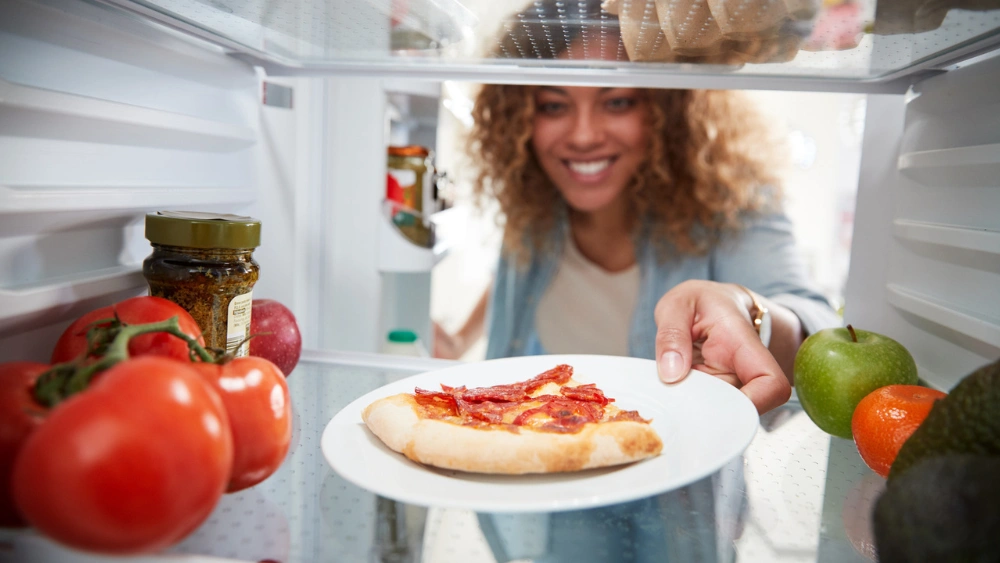You’ve just finished a delicious pizza, but now you’re wondering how long those tasty leftovers can safely stay in your fridge. You don’t want to risk eating spoiled food, but you also don’t want to waste a single slice.
Knowing exactly how long pizza stays good in the fridge can save you money, keep you healthy, and help you enjoy your favorite meal again later without worry. Keep reading, and you’ll discover the simple rules to keep your pizza fresh, tasty, and safe to eat every time.
Pizza Shelf Life In The Fridge
Storing pizza in the fridge is a common practice, but many wonder how long it actually stays good. Knowing the shelf life of pizza in the fridge helps you avoid wasting food and keeps you safe from eating spoiled slices. Let’s look at how long you can expect your refrigerated pizza to remain fresh and what affects its quality.
Typical Storage Duration
Generally, pizza can stay fresh in the fridge for about 3 to 4 days. This timeframe applies whether it’s homemade or from a restaurant. After this period, the risk of bacteria growth increases, and the texture and flavor start to decline.
Have you ever noticed your leftover pizza turning soggy or tasting off after a few days? That’s a sign it’s past its prime. To enjoy your pizza safely, try to eat it within this window.
Factors Affecting Freshness
Several factors can change how long your pizza stays good in the fridge. The type of toppings plays a big role—meat toppings like pepperoni or sausage may spoil faster than vegetables. Also, the way you store the pizza matters a lot.
- Storage container:Airtight containers or wrapping pizza tightly with plastic wrap helps prevent moisture loss and slows bacterial growth.
- Fridge temperature:Keeping your fridge at or below 40°F (4°C) is essential for maintaining pizza freshness.
- Initial pizza quality:Pizza that was left out too long before refrigeration will spoil faster.
Next time you stash your pizza in the fridge, think about these factors. Could adjusting how you store it extend its delicious life? What small changes might keep your leftovers tasting fresh longer?

Credit: www.facebook.com
Signs Of Spoiled Pizza
Knowing the signs of spoiled pizza can save you from an unpleasant meal and potential foodborne illness. Spoiled pizza often shows clear indicators that it’s no longer safe or tasty to eat. Learning to spot these signs helps you decide if your leftover pizza is still good or if it’s time to toss it.
Visual Indicators
Look closely at the pizza for any unusual changes in appearance. Mold is a common and obvious sign of spoilage—green, white, or black fuzzy spots indicate the pizza has gone bad. Also, check if the crust looks excessively dried out or if the cheese has separated and turned oily or discolored.
Sometimes, leftover pizza may develop a slimy or sticky film on the surface. This texture change often means bacteria are growing, which is a red flag. If you notice any strange spots or textures, it’s safer to discard the pizza rather than risk your health.
Smell And Texture Changes
Fresh pizza should have a pleasant aroma of melted cheese and toppings. If your pizza smells sour, rancid, or just “off,” it’s a strong sign that bacteria or mold are present. Even a faint sour smell shouldn’t be ignored, especially if the pizza has been in the fridge for more than 3-4 days.
Texture is just as important as smell. Pizza that feels unusually mushy or sticky, especially on the crust or cheese, is likely spoiled. Have you ever bitten into a slice that seemed fine but felt weird? That strange texture often signals spoilage before you even taste it.
Best Practices For Storing Pizza
Storing pizza correctly can make a big difference in how long it stays fresh and tasty. You want to keep the flavors locked in and avoid drying out the crust or toppings. Let’s look at some smart ways to store your pizza so every slice tastes as good as the first.
Proper Wrapping Techniques
Wrapping pizza properly keeps it from absorbing fridge odors and prevents moisture loss. Use plastic wrap or aluminum foil to cover the slices tightly. Make sure to press the wrap close to the surface of the pizza to reduce air exposure.
If you have multiple slices, separate them with a piece of parchment paper before wrapping. This stops the slices from sticking together and makes it easier to grab just one later. Do you ever find your pizza slices sticking and tearing when you try to reheat? This simple step can save you that hassle.
Ideal Container Choices
Choosing the right container is just as important as wrapping. Airtight containers are excellent because they create a sealed environment that keeps moisture in and other smells out. Glass or BPA-free plastic containers work well.
Containers with a flat base prevent the pizza from getting squished, keeping the toppings intact. If you’re short on container space, stacking slices with parchment paper in between inside a large, sealable bag can also do the trick. What’s your go-to storage container for leftovers? Maybe it’s time to rethink it.

Credit: m.facebook.com
Reheating Tips For Leftover Pizza
Reheating leftover pizza can be tricky. It needs to be hot but still tasty. The goal is to keep the original flavor and texture. Using the right reheating method makes all the difference.
Here are some tips to enjoy your pizza like it’s fresh from the oven.
Methods To Retain Flavor
To keep the pizza flavorful, try reheating it gently. Avoid microwaving for too long because it can make the crust soggy. Instead, use these methods:
- Heat in a skillet over medium heat for a few minutes. This keeps the crust crispy.
- Use an oven preheated to 375°F (190°C). Place pizza on a baking sheet and heat for 8–10 minutes.
- Try a toaster oven for smaller slices to warm evenly without drying out.
These methods keep the cheese melty and toppings tasty.
Avoiding Dryness
Dry pizza is never enjoyable. To prevent dryness, add a small water source nearby while reheating. For example:
- Place a small oven-safe cup of water in the oven. It creates steam to keep pizza moist.
- Cover the pizza loosely with foil to trap moisture but allow heat to circulate.
- Do not overheat. Check often to avoid burning or drying out.
These simple steps help keep your pizza juicy and delicious.
Health Risks Of Eating Old Pizza
Eating old pizza can cause health problems. Pizza left too long in the fridge can grow harmful bacteria. These bacteria can make you sick in many ways. It is important to know the risks before eating leftover pizza.
Common Foodborne Illnesses
Old pizza can carry bacteria that cause food poisoning. Some common illnesses include:
- Salmonella:Causes stomach pain, diarrhea, and fever.
- Listeria:Can lead to severe infections, especially in pregnant women.
- E. coli:Causes cramps, vomiting, and diarrhea.
- Staphylococcus aureus:Produces toxins that cause nausea and vomiting.
These bacteria grow quickly if pizza is stored too long or not kept cold enough.
When To Discard Leftovers
Pizza usually stays safe in the fridge for 3 to 4 days. Beyond this time, bacteria increase and risk grows.
Throw out pizza if it shows signs like:
- Bad or sour smell
- Visible mold
- Unusual slimy texture
Always store pizza in an airtight container to keep it fresh longer. Never eat pizza left out at room temperature for more than 2 hours.

Credit: crustdiaries.com
Freezing Pizza For Longer Storage
Freezing pizza is a smart way to keep it fresh for a longer time. It slows down the growth of bacteria and stops the pizza from spoiling quickly. This method works well for both homemade and store-bought pizza. Proper wrapping and storage are important to avoid freezer burn and keep flavors intact. Frozen pizza can stay good for up to 1-2 months without losing much taste or texture.
How Freezing Extends Shelf Life
Freezing pizza lowers the temperature to stop bacteria growth. It preserves the pizza’s quality by halting spoilage. The cold keeps ingredients like cheese and sauce fresh. Wrapped well in plastic or foil, pizza stays moist and tasty. Freezing also helps keep the crust from getting soggy. This method is best for saving extra slices or whole pizzas.
Thawing And Reheating Frozen Pizza
Thaw pizza in the fridge for several hours or overnight. This keeps it safe and prevents bacteria growth. For faster thawing, use a microwave but watch the crust. Reheat pizza in an oven or toaster oven to keep the crust crisp. Avoid reheating too long to prevent dryness. A hot oven at 375°F (190°C) for 10-15 minutes works well. Check pizza often to get the best texture and taste.
Frequently Asked Questions
How Long Does Pizza Stay Good In The Fridge?
Pizza stays good in the fridge for 3 to 4 days. Store it in an airtight container to maintain freshness. Consuming it within this period ensures taste and safety.
Can I Eat Leftover Pizza After A Week?
Eating leftover pizza after a week is not recommended. The risk of bacterial growth and foodborne illness increases significantly. Always discard pizza older than 4 days for safety.
How Should I Store Pizza In The Fridge?
Store pizza in an airtight container or wrap tightly with plastic wrap. This prevents moisture loss and bacterial contamination, keeping the pizza fresh for up to 4 days.
Does Reheating Pizza Affect Its Safety?
Reheating pizza does not improve safety if it’s already spoiled. Always refrigerate promptly and consume within 4 days. Proper reheating ensures taste but not safety from bacteria.
Conclusion
Pizza stays good in the fridge for about 3 to 4 days. Keep it in an airtight container to stay fresh longer. Eat leftover pizza within this time to avoid bad taste or sickness. Always check for strange smells or mold before eating.
Storing pizza properly helps keep its flavor and texture. Enjoy your pizza safely by following these simple tips. Don’t let good pizza go to waste!

